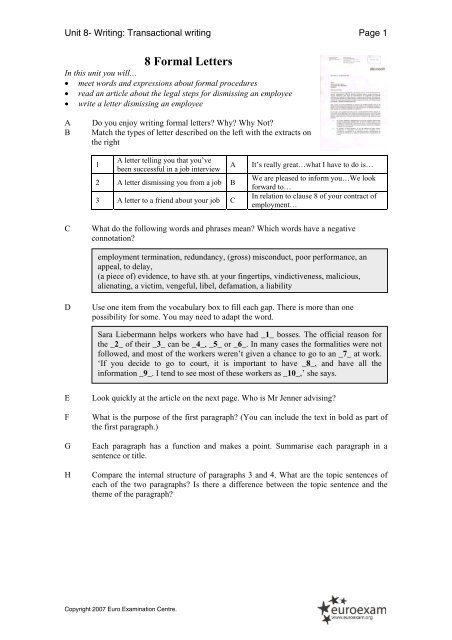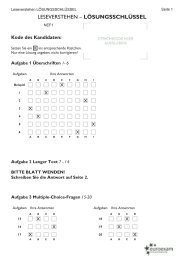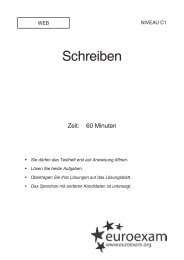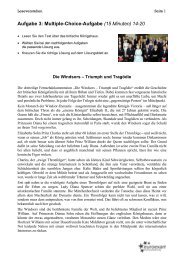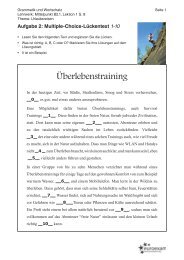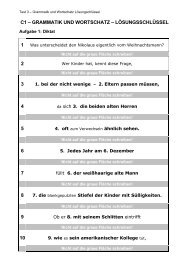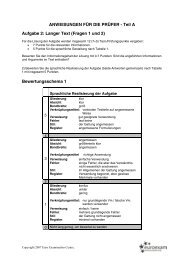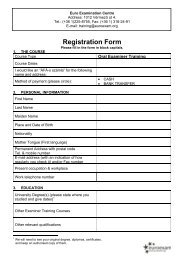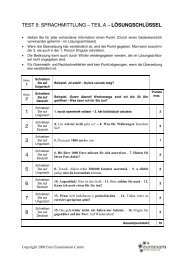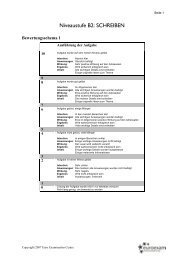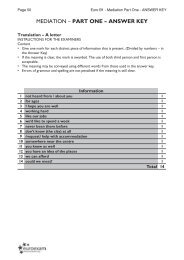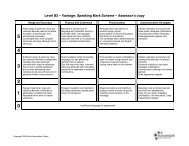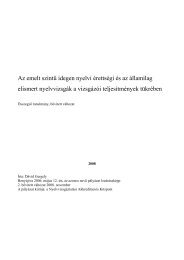12 Formal Letters - Euroexam
12 Formal Letters - Euroexam
12 Formal Letters - Euroexam
You also want an ePaper? Increase the reach of your titles
YUMPU automatically turns print PDFs into web optimized ePapers that Google loves.
Unit 8- Writing: Transactional writing Page 1<br />
8 <strong>Formal</strong> <strong>Letters</strong><br />
In this unit you will…<br />
• meet words and expressions about formal procedures<br />
• read an article about the legal steps for dismissing an employee<br />
• write a letter dismissing an employee<br />
A Do you enjoy writing formal letters? Why? Why Not?<br />
B Match the types of letter described on the left with the extracts on<br />
the right<br />
1<br />
A letter telling you that you’ve<br />
been successful in a job interview<br />
2 A letter dismissing you from a job B<br />
3 A letter to a friend about your job C<br />
A It’s really great…what I have to do is…<br />
We are pleased to inform you…We look<br />
forward to…<br />
In relation to clause 8 of your contract of<br />
employment…<br />
C What do the following words and phrases mean? Which words have a negative<br />
connotation?<br />
employment termination, redundancy, (gross) misconduct, poor performance, an<br />
appeal, to delay,<br />
(a piece of) evidence, to have sth. at your fingertips, vindictiveness, malicious,<br />
alienating, a victim, vengeful, libel, defamation, a liability<br />
D Use one item from the vocabulary box to fill each gap. There is more than one<br />
possibility for some. You may need to adapt the word.<br />
Sara Liebermann helps workers who have had _1_ bosses. The official reason for<br />
the _2_ of their _3_ can be _4_, _5_ or _6_. In many cases the formalities were not<br />
followed, and most of the workers weren’t given a chance to go to an _7_ at work.<br />
‘If you decide to go to court, it is important to have _8_, and have all the<br />
information _9_. I tend to see most of these workers as _10_,’ she says.<br />
E Look quickly at the article on the next page. Who is Mr Jenner advising?<br />
F What is the purpose of the first paragraph? (You can include the text in bold as part of<br />
the first paragraph.)<br />
G Each paragraph has a function and makes a point. Summarise each paragraph in a<br />
sentence or title.<br />
H Compare the internal structure of paragraphs 3 and 4. What are the topic sentences of<br />
each of the two paragraphs? Is there a difference between the topic sentence and the<br />
theme of the paragraph?<br />
Copyright 2007 Euro Examination Centre.
Unit 8- Writing: Transactional writing Page 2<br />
I Look at the following paragraph from a review of Mr Jenner’s article. Is the letter<br />
logically ordered? Re-write it.<br />
He is completely partisan. For Jenner the purpose of keeping records is solely to<br />
empower the boss, not the worker. Jenner’s article reveals everything which is<br />
wrong with management consultancy today. Jenner writes entirely from the<br />
employer’s point of view. He says bosses should avoid vindictiveness, not because it<br />
hurts the employee, but only because it can cause problems for the employer.<br />
J Reply to the following email in not more than 150 words. Advise Wayne on the what<br />
steps he would have to take to make the dismissal legal.<br />
Hi<br />
I hope you are feeling better than I am. This new chap has just borrowed one<br />
of our company vans to go off and get himself some lunch. When he gets back in<br />
a minute, I’m going to call him a fool and an idiot and sack him on the spot.<br />
How are things with you?<br />
Wayne,<br />
Wayne Shatner, Shatner Catering, 7-11 Park St. 3830 Meckham.<br />
Giving formal notification – real-life phrases<br />
I hereby give notice that…<br />
I have been asked to inform you… (writing for somebody else)<br />
With reference to clause 4 of your contract…<br />
Copyright 2007 Euro Examination Centre.
Unit 8- Writing: Transactional writing Page 3<br />
Good-bye <strong>Letters</strong><br />
Writing letters terminating employment contracts is not easy.<br />
Management consultant Hector Jenner provides some advice.<br />
(1) Whenever you write any kind of official<br />
letter there are two things that it is vital to<br />
get right: the style and the content.<br />
Assuming you have mastered proper<br />
business style, here I will concentrate only<br />
on the content.<br />
(2) Employers must use proper employment<br />
termination and dismissal procedures to<br />
ensure that the process when an employee<br />
leaves is professionally and legally correct.<br />
There are severe costs to the firm if<br />
employment termination is, for whatever<br />
reason, not handled properly.<br />
(3) Employment termination by the<br />
employer normally falls into one of these<br />
categories: redundancy, misconduct or poor<br />
performance. Poor performance may or<br />
may not be the fault of the employee; s/he<br />
might be doing his/her best but his/her best<br />
is simply not good enough. The central<br />
principles for dealing with all three of these<br />
situations are broadly similar.<br />
(4) There are basic steps that need to be<br />
followed properly. First, give reasons for<br />
the proposed dismissal to the employee in<br />
writing, and give the employee a reasonable<br />
period during which to consider the facts<br />
and his/her response. Second, hold a<br />
meeting with the employee to explain the<br />
reasons and give the employee the<br />
opportunity to explain his/her position.<br />
Third, after the meeting, give the employee<br />
your decision in writing (whether to<br />
proceed with the dismissal or other action),<br />
and invite the employee to make an appeal<br />
and attend an appeal meeting. After any<br />
appeal meeting the employer must confirm<br />
the appeal decision in writing. A manager<br />
of proper authority must attend meetings,<br />
Dear Miss Fletcher,<br />
and meetings must<br />
be at reasonable<br />
times and venues.<br />
The employer must<br />
also not<br />
unreasonably delay<br />
any of the stages in this process.<br />
(5) The above process means a minimum of<br />
three official letters. <strong>Letters</strong> should<br />
concentrate on the facts of the situation, and<br />
the clear evidence to support these facts.<br />
Having facts and figures at management’s<br />
fingertips requires good record-keeping. An<br />
essential part of a properly run firm is the<br />
keeping of accurate day-to-day records on<br />
every aspect of an employee’s conduct.<br />
Nothing could be worse than getting into<br />
the middle of a dismissal process and<br />
finding basic facts and figures are lacking.<br />
(6) Even in cases of gross misconduct,<br />
avoid vindictiveness; there is no money to<br />
be made from it, and unnecessary hostility<br />
may cause management problems later.<br />
Any subsequent legal review process will<br />
not look kindly on any aspects of malicious<br />
behaviour used in the employer's handing<br />
of a dismissal.<br />
(7) As a matter of good practice, always try<br />
to part as friends, not enemies. Nothing is<br />
gained by alienating people who already<br />
see themselves as victims; negative<br />
treatment can prompt them to be vengeful,<br />
which does nobody any good at all. Also,<br />
by keeping employment termination and<br />
dismissal letters positive you avoid the risk<br />
of libel or defamation, which carry potential<br />
legal liabilities for the employer,<br />
irrespective of the circumstances and<br />
process of the dismissal itself.<br />
Further to our meeting held earlier today, I regret to inform you that your employment<br />
with Bibby and Jenner is terminated with effect from Friday 14 June.<br />
Copyright 2007 Euro Examination Centre.
Unit 8- Writing: Transactional writing Page 4<br />
Exam Skills<br />
A Look at the letter template below. On a separate sheet of paper, write out the<br />
formalities: letterhead and closure (i.e. the position of the sender’s name and address,<br />
the recipient’s name and address, salutations, the date and the reference).<br />
Exam tip: you do not need to reproduce addresses in the exam, but you need to<br />
recognise who the letter is from and who it is to.<br />
B Look at the letter template again. What is the purpose/function<br />
of each paragraph?<br />
Exam tip: your letter in the exam needs a clear structure,<br />
through logical paragraphing.<br />
C What is the function of the pieces of formal language<br />
highlighted in the text?<br />
Exam tip: you need to use appropriate register in formal<br />
letters.<br />
D You are Mr Jenner’s assistant. Using the template below, write a letter dismissing Miss<br />
Fletcher, the trainee management consultant. Invent details, but be realistic. Your letter<br />
should look authentic.<br />
Name, address, date, reference<br />
Dear Mr/Ms/Mrs ………..<br />
(1) Further to our meeting of (date), I (regretfully) confirm that your employment with us is<br />
terminated with effect from (date)/with immediate effect.<br />
(2) As stated at our meeting, the reason(s) for terminating your employment with us is/are as<br />
follows:<br />
(Employer must clearly state reasons – transgressions and relevant policies if applicable.)<br />
(3) (Employer must clearly state previous warnings – informal, formal, written etc. – the<br />
circumstances for each warning and the person's response and subsequent<br />
behaviour/performance.)<br />
(4) (Clearly state requirements regarding return of documentation, equipment, car,<br />
submission of final expenses claims, and any other leaving administration issues.)<br />
(5) (Clearly state actual leaving date, requirement or otherwise to serve period of notice,<br />
holiday pay, and other pay and pension details.)<br />
(6) (Optional sign-off, for example: Thank you for your past efforts and all the best for your<br />
future endeavours.)<br />
Yours sincerely,.<br />
name and position<br />
(Optional section requiring person to sign, confirming receipt, and return copy of this letter.)<br />
E Swap your letter with a partner. Discuss how effective the letter is, and check for<br />
spelling and punctuation.<br />
Copyright 2007 Euro Examination Centre.
Unit 8- Writing: Transactional writing Page 5<br />
Exam Practice: Mr Bibby gets angry with Miss Jowell<br />
A List behaviour which is acceptable (and unacceptable) in an office which deals<br />
with high-paying professional clients (e.g. coming to work in jeans).<br />
B What information should go into a warning letter to an employee?<br />
C Read Mr Bibby’s letter. What kind of person is Mr Bibby?<br />
Bibby and Jenner are a leading firm of management consultants. As Mr Bibby’s<br />
personal assistant you have received the following emails.<br />
To assistant@bibbyandjenner.com<br />
From rbibby@bibbyandjenner.com<br />
I am so angry that I can hardly write this e-mail!!!<br />
This morning I had a meeting in my room with representatives from a very<br />
important client of ours. Throughout, a noisy circus seemed to be going on outside<br />
in the corridor. The main culprit was undoubtedly the new trainee in the office, Miss<br />
Jowell, who:<br />
• was shouting to her colleagues (I can never stand the shrill sound of young<br />
women’s voices when they are shouting)<br />
• was using language which was vulgar<br />
• brought in our coffee at 11am, and banged it down on the table, spilling a fair<br />
proportion of it into the saucers.<br />
Please draft an official warning letter to Miss Jowell, and mention clearly the<br />
standards that Bibby and Jenner expects from its employees. Bring it to me for<br />
signature when you’ve finished.<br />
Take any other steps you think necessary to deal with this matter. I’m too busy to<br />
give it any more time.<br />
Ralph Bibby, Senior Partner, Bibby and Jenner.<br />
To assistant@bibbyandjenner.com<br />
From hjenner@bibbyandjenner.com<br />
There will be a senior staff meeting on Thursday at 9.00. If a matter needs placing<br />
on the agenda, notify the office manager, Miss Gold, by 13.00 on Tuesday.<br />
H. Jenner, Senior Partner, Bibby and Jenner.<br />
D Write a letter to Miss Jowell, as Mr Bibby instructs. (About 200 words)<br />
E Write an email to Miss Gold, giving a short explanation of the matter as an item to be<br />
included in the senior staff meeting agenda. (About 50 words)<br />
F Write the full agenda for the senior staff meeting on Thursday. Act it out in groups of<br />
three.<br />
(Tasks E and F are not examination tasks)<br />
Copyright 2007 Euro Examination Centre.
Unit 8- Writing: Transactional writing Page 6<br />
Unit 8: <strong>Formal</strong> <strong>Letters</strong><br />
(p.1) B 1B, 2C, 3A <strong>Letters</strong> 1 and 2 are formal; 3 is informal. A dismissal letter will be<br />
more formal and legalistic in style than a letter of appointment which will<br />
probably have an optimistic tone.<br />
(p.1) C employment termination, redundancy, (gross) misconduct, poor performance,<br />
vindictiveness, malicious, alienating, a victim, vengeful, libel, defamation, a<br />
liability, to delay<br />
(p.1) D 1. vindictive, malicious, vengeful, 2. termination, 3. employment,<br />
4./5./6. redundancy, misconduct, poor performance (in any order), 7. appeal, 8.<br />
evidence, 9. at your fingertips, 10. victims<br />
(p.1) E employers<br />
(p.1) F to establish the topic of the article (i.e. the correct contents of a letter of<br />
dismissal)<br />
(p.1) G 1. Getting the style and content right, 2. Use correct procedures, 3. Types of<br />
dismissal, 4. Detailed steps of a dismissal, 5. Keeping records and evidence,<br />
6. Avoid vindictiveness, 7. Try to part on friendly terms<br />
(p.1) H In both 3 and 4 the topic sentence is the first. Paragraph 3, after the topic<br />
sentence, details one aspect and then finishes with a transitional sentence<br />
linking to the next paragraph. Paragraph 4, after the topic sentence, details a<br />
procedure chronologically.<br />
(p.1) I The sentences in the paragraph do not follow a logical order. A possible<br />
correction could be:<br />
Jenner’s article reveals everything which is wrong with management<br />
consultancy today.<br />
(= main thesis statement) Jenner writes entirely from the employer’s point<br />
of view. (= further specification of thesis) He is completely partisan.<br />
(=reformation of specific thesis) He says bosses should avoid<br />
vindictiveness, not because it hurts the employee, but only because it can<br />
cause problems for the employer. (= example and illustration of thesis) For<br />
Jenner the purpose of keeping records is solely to empower the boss, not the<br />
worker. (= another example and illustration of thesis)<br />
This paragraph identifies the topic/thesis at the beginning, then<br />
proves/illustrates/exemplifies it in the body of the paragraph. Normal paragraph<br />
structure moves from the general to the specific.<br />
(p.1) J The letter should remind Wayne of the correct procedures if he wishes to<br />
dismiss an employee. The letter to the employee should be written in a formal<br />
style. He should try not to part with the employee on unfriendly terms. But your<br />
letter to Wayne will be informal.<br />
(p. 3) A This is a suggested format for a formal letter<br />
Copyright 2007 Euro Examination Centre.
Unit 8- Writing: Transactional writing Page 7<br />
Mr G. Schlick<br />
Management Consultant<br />
<strong>12</strong> Green Rd.<br />
2567 Meckham<br />
Dear Mr Schlick,<br />
Re: your employment contract<br />
I am writing to inform you…<br />
Yours sincerely,<br />
H. Jenner<br />
Senior Partner<br />
Bibby and Jenner Management Consultancy<br />
436 The Grenberg Ring<br />
2318 Grenberg<br />
<strong>12</strong> February 2007<br />
(p.3) B 1. announcement of employment termination, 2. reasons for termination,<br />
3. history of the case to date, 4. what will happen next, 5. further details of<br />
termination, 6. final comments on termination<br />
(p.3) C These are formulaic pieces of writing used to structure the information in the<br />
letter.<br />
(p.4) C Mr Bibby appears to be intolerant, bad tempered and impatient.<br />
Copyright 2007 Euro Examination Centre.


